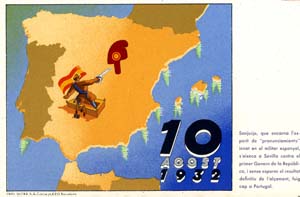10 AGOST 1932
Sanjurjo, que encarna l'esperit de "pronunciamento" innat en el militar espanyol, s'aixeca a Sevilla contra el primer Govern de la República, i sense esperar el resultat definitiu de l'alçament, fuig cap a Portugal.
Sanjurjo, que encarna el espíritu de "pronunciamento" innato en el militar español, se levanta en Sevilla contra el primer Gobierno de la República y sin esperar el resultado definitivo del levantamiento, huye hacia Portugal
Sanjurjo démontrant une fois de plus l'esprit de "pronunciamento" inné chez militaire espangol, se soulève à Séville contre le premier Gouvernement de la République, puis, sans attendre le résultat définitive de rébellion, s'enfuit au Portugal
Sanjurjo, the incarnation of the absolutist spirit of the typical Spanish army commander, leads in Sevilla an armed uprising against the first Government of the Republic, and flees to Portugal to without waiting for the outcome.
Sanjurjo, personiganta en si la spiriton de "sinmemproklamo", deciama en la hispana militista, ribelas en Seviljo kontrau[sic] la unua Registaro de la Respubliko kaj ne atendante la definitivan rezultan de la ribelo, li forkuras al Portugalujo.
The attempted coup d'état of August 1932 presented the first major threat to the republican government. Though planning reached as far back as the creation of the Second Republic, the immediate cause of the attack originated from the pending passage of the Catalan State of Autonomy that was considered by some, especially within military circles, as tantamount to the dissolution of the Spanish state. Sanjurjo remained in exile until 1936, and died in a plane crash attempting to reenter Spain in the opening days of the Spanish Civil War.
Reappearing for a third time, the red cap and cockade appears opposite a caricature of General Sanjurjo standing with sward drawn. The general stands inside what is perhaps meant to portray the Alcazar of Seville, identified by its mujédar battlements. To his back, the red-yellow-red stripes of the Alphonsine flag would have been identified by contemporaries as the same used by the Nationalists in the Spanish Civil War. The republican government retired this banner in favor of a red-yellow-purple combination in 1931.

